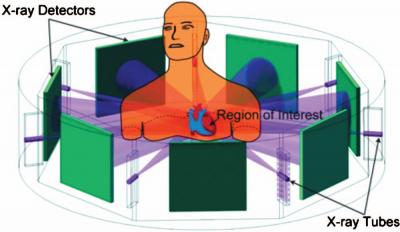A new CT generation takes shape: thinking outside the circle
A new CT generation takes shape as vendors introduce designs that cut dose and increase resolution.
Thirty-three years ago, University Hospitals in Madison, WI, unveiled to the local media a device that just about everybody had some fun with, the CAT scanner. Working as I was at the time for the UW medical school, I wrote the story for that unveiling. Dutifully I stepped aside as my boss lay on the table for faux pictures and video of the device “in action.” Publication of a cartoon cat looking intensely through a magnifying glass at a patient took the bite out of being nudged from my 15 minutes of fame. The cartoon was amusing, consoling, and yet insulting.
I had a “feline” (sorry…at long last I can laugh about it) that CAT scans would change the practice of medicine. What I didn’t know was that the basic design of this technology, a single source of x-rays rotating around a patient, would persist for so long. Finally this era may be coming to an end.
The first chink in CT’s armor came with Siemens’s introduction a couple of years back of dual-source CT, which built two x-ray imaging chains, one at a 90° angle to the other, in the same gantry. Now word is circulating of a design that takes this idea much further.

Engineers at Virginia Tech – Wake Forest University and GE Global Research Center are developing a prototype cardiac CT scanner built on the concept of “interior tomography.” This concept calls for up to seven x-ray sources focused on a region of interest; in this case, the heart. The beams generate data that are processed to mathematically “skip” the bone and muscle that otherwise degrade image quality and necessitate high radiation dose. The design promises to cut dose dramatically while increasing spatial and temporal resolution, a radiological hat trick sure to please medical practitioners, patients, and the burgeoning corps of dose police at the FDA.
It is as though history is repeating itself with a slightly different twist. Eighteen years ago, as the imaging world was converting from step-and-shoot to spiral (also called helical) CT, maverick multimodality vendor Elscint came out with the CT-Twin, which delivered two slices for every rotation of its x-ray tube.
Major CT vendors, predictably, snubbed the idea. They had just launched a new generation of scanners built around a moving patient table. They needed to recoup their R&D investments. Alone in the market, Elscint’s dual-slice scanner languished and the idea of multislice scanning lay fallow until 1998, when the first quad-slice scanners leapfrogged the CT-Twin and the current generation of scanners was born.
Today market conditions are similar to those of 12 years ago. The clinical advantages to be gained from multislice CT have been achieved, as had those of spiral CT. Sales of CT scanners are on the decline as software upgrades extend the lives of installed systems. Vendors are desperately in need of something new to reenergize their portfolios.
The imaging community could soon welcome exactly that, a fantastic new generation of scanners, one that most CT practitioners cannot at this time imagine, yet one that vendors have foreseen for years. The harbingers of this coming technology are visible, but only if you know where to look. The Virginia Tech researchers working with GE, and others in the academic community, have been publishing research findings about interior tomography for years. The most recent appeared in the August issue of Medical Physics (Wang G, Yu H, Ye Y. A scheme for multisource interior tomography. 2009;36[8]: 3575-3581).
The patent covering the work being done by GE was issued April 13 (Patent 7,697,658 "Interior tomography and instant tomography by reconstruction from truncated limited-angle projection data"), but a description of the idea contained in the patent application appeared more than a year earlier. The proof of concept that evolved from the idea underlying the patent was the basis for NIH funding, which GE and Virginia Tech are using to develop the concept further. Information about this grant is publicly available from NIH.
The makers of CT scanners are, as one industry executive recently told me, engaged always in multiple chess games whose outcomes, new products and upgrades, will not be seen for years yet. GE and Virginia Tech have come to where they are today by making moves based on thinking three or four moves ahead. Their work has not been done in a vacuum, nor has it escaped the attention of competitors, which have likely been making moves of their own.
An industry in which players are well aware of each other’s efforts in product development was the reason GE, Siemens, and Toshiba each came out with quad-slice scanners within a few months of each other in 1998. Picker followed soon after, not coincidentally, by purchasing the CT assets of defunct Elscint Picker.
It is the reason that the next great change in CT technology will seem to appear suddenly-and not with a meow but with a roar.
Meta-Analysis Shows Merits of AI with CTA Detection of Coronary Artery Stenosis and Calcified Plaque
April 16th 2025Artificial intelligence demonstrated higher AUC, sensitivity, and specificity than radiologists for detecting coronary artery stenosis > 50 percent on computed tomography angiography (CTA), according to a new 17-study meta-analysis.
The Reading Room: Racial and Ethnic Minorities, Cancer Screenings, and COVID-19
November 3rd 2020In this podcast episode, Dr. Shalom Kalnicki, from Montefiore and Albert Einstein College of Medicine, discusses the disparities minority patients face with cancer screenings and what can be done to increase access during the pandemic.
Could Lymph Node Distribution Patterns on CT Improve Staging for Colon Cancer?
April 11th 2025For patients with microsatellite instability-high colon cancer, distribution-based clinical lymph node staging (dCN) with computed tomography (CT) offered nearly double the accuracy rate of clinical lymph node staging in a recent study.